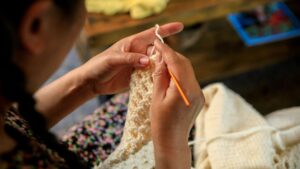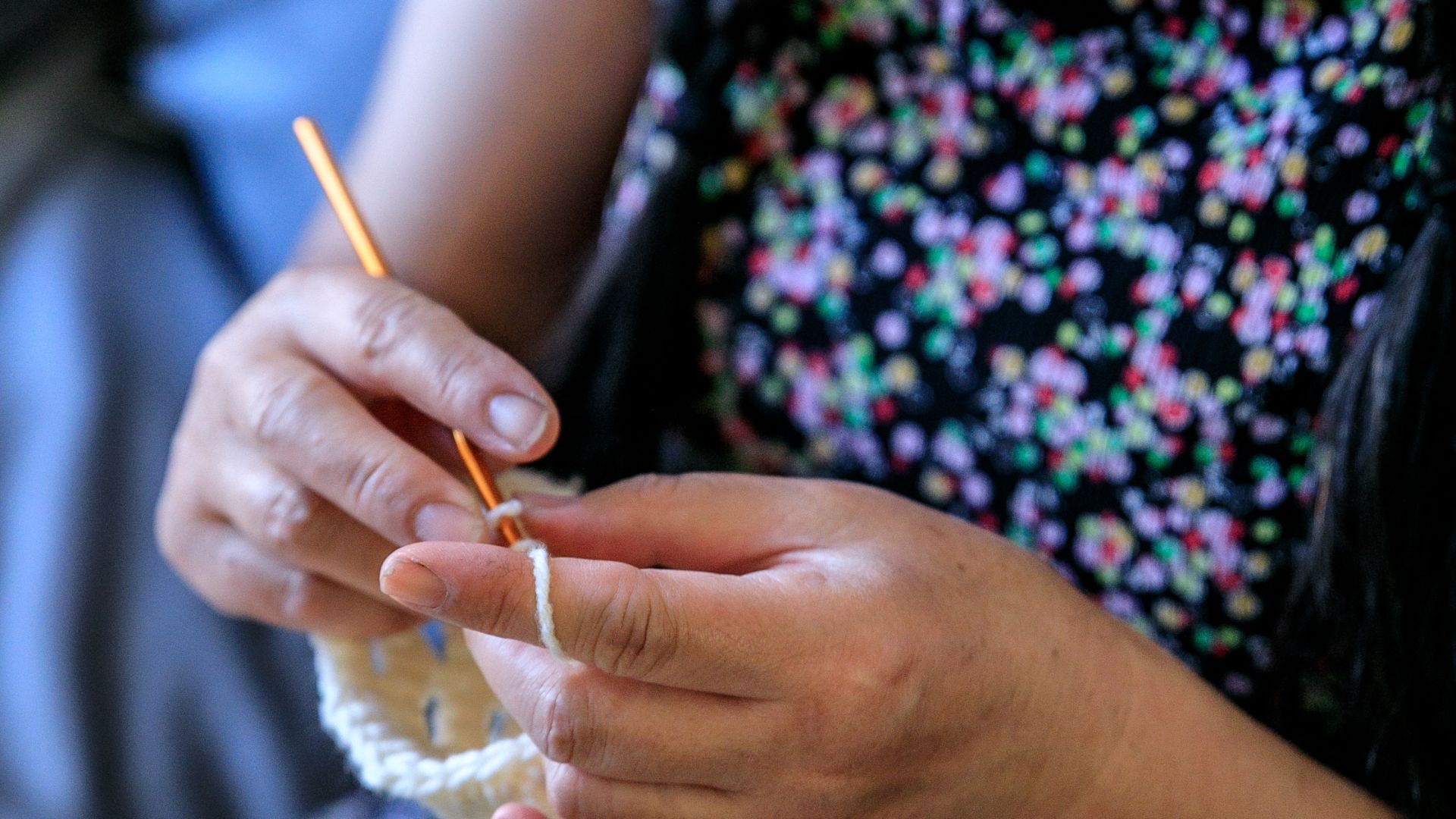Crocheting is a delightful craft that allows you to create beautiful pieces using yarn and a crochet hook. However, if you’ve ever noticed your crochet work twisting or curling unexpectedly, you’re not alone! Let’s explore the reasons behind this curious phenomenon and how to prevent it.
Understanding the Twist:
When your crochet work starts to twist or curl, it’s often due to the tension in the yarn and the way you’re holding the hook. There are a few common culprits to consider:
1. Yarn Tension:
The tension in your yarn plays a crucial role. If you consistently pull the yarn too tightly or too loosely as you crochet, it can cause your work to twist. Aim for a consistent tension throughout your project, neither too tight nor too loose, to maintain the shape and prevent twisting.
2. Stitch Direction:
The direction in which you crochet stitches can also impact the twist. Certain crochet stitches, like the Tunisian or single crochet, tend to create more twist compared to others. Experimenting with different stitches might help alleviate the twisting issue.
3. Hook Grip:
How you hold your crochet hook matters. If you’re twisting your wrist or applying uneven pressure while crocheting, it can result in your work twisting or curling. Maintaining a relaxed grip and holding the hook comfortably can make a significant difference.
Preventive Measures:
Now that we’ve identified potential causes, let’s delve into some preventive measures to keep your crochet work from twisting:
Adjust Your Tension:
Be mindful of your yarn tension. Practice keeping it consistent by not pulling the yarn too tightly or letting it become too loose as you work.

Experiment with Stitches:
Try different crochet stitches and observe how they affect the twist in your project. Sometimes, a simple switch in stitching technique can solve the twisting problem.
Relax Your Grip:
Pay attention to your hand and wrist posture while crocheting. A relaxed grip and a comfortable wrist position can minimize unwanted twists in your work.
So,…
twists and curls can be a common hiccup in your crafting journey. However, understanding the reasons behind these twists and implementing simple adjustments in yarn tension, stitching, and grip can significantly reduce or eliminate the issue.
practice makes perfect! Embrace these tips and tricks as you embark on your crochet adventures, ensuring that your creations are beautifully crafted, free from unexpected twists and turns.
External Resources:
Troubleshooting Twists: Advanced Tips for Flawless Crochet Work
Diving deeper into the art of crochet, let’s explore additional strategies and troubleshooting tips to overcome twists in your projects and elevate your crafting experience.
Yarn Choices Matter:
4. Yarn Characteristics:
The type of yarn you use can influence the twist in your crochet work. Some yarn fibers have a natural tendency to twist or curl, affecting the overall appearance of your project. Experiment with different yarn types and textures to find the ones that minimize twisting.
5. Blocking and Tension Adjustment:
After completing your crochet project, blocking can work wonders. Blocking involves wetting or steaming your finished piece and reshaping it to lay flat. This process can help relax the yarn fibers and eliminate twists. Additionally, adjusting the tension during blocking can refine the shape of your creation.
Techniques for Twist-Free Crochet:
6. Alternate Stitching Methods:
Consider working in the round or using techniques like “turning chains” to counteract twists. These methods redistribute tension more evenly, reducing the likelihood of your work spiraling unexpectedly.
7. Check Your Pattern:
Sometimes, the pattern itself might inadvertently contribute to twisting. Ensure you’re following the instructions correctly and consider reaching out to crochet communities or forums for pattern-specific advice if twists persist.
Advanced Practices:
8. Stitch Count Awareness:
Maintaining the correct number of stitches in each row or round is crucial. Accidentally adding or skipping stitches can cause your work to twist. Counting your stitches periodically helps maintain the desired shape.
9. Blocking Techniques:
Experiment with different blocking methods such as wet blocking, steam blocking, or pin blocking. Each technique can have varying effects on the twist and overall appearance of your project.
Mastering the art of crochet involves honing your skills and adapting techniques to create flawless, twist-free creations. By being mindful of yarn choices, adjusting tension, experimenting with stitching methods, and utilizing advanced practices like blocking, you can elevate your crochet game to new heights.
Crafting is a journey of discovery and creativity. Embrace these advanced tips, troubleshoot twists with confidence, and continue to enjoy the fulfilling and artistic world of crochet.
External Resources:
Mastering Crochet: Refining Techniques for Twist-Free Creations
Let’s delve deeper into the world of crochet and explore some advanced techniques and troubleshooting methods that will help you create stunning, twist-free projects.
Advanced Stitching Strategies:
10. Joining Techniques:
When working in the round, the method used to join rounds can impact twist formation. Experiment with different joining techniques, such as slip stitching, to minimize twists and create a seamless appearance in your rounds.
11. Directional Crochet:
Understanding the direction of your stitches is crucial. Some stitches tend to lean or pull in certain directions, potentially causing twists. Experiment with altering the direction or orientation of your stitches to counteract this effect.
Precision and Attention to Detail:
12. Consistency in Stitch Height:
Maintaining consistent stitch height throughout your project is vital. Variations in stitch height can lead to an uneven surface, causing twists or ripples. Focus on achieving uniformity in your stitches to create a smooth and twist-free fabric.
13. Blocking Mastery:
Enhance your blocking skills by exploring advanced blocking techniques. Try using specific tools like blocking mats and T-pins to precisely shape and manipulate your crochet projects during the blocking process.
Expert Troubleshooting:
14. Tension Adjustment during Crochet:
Learn to adjust tension while crocheting. Being able to identify and correct tension issues on the go can prevent twists from forming as you work through your project.
15. Stitch Marker Placement:
Strategic placement of stitch markers can help you keep track of stitch counts and identify any irregularities promptly. This aids in maintaining the integrity of your work and prevents twists caused by stitch miscounts.
Conclusion:
Achieving twist-free crochet work requires a combination of expertise, attention to detail, and mastery of advanced techniques. By refining your stitching methods, mastering joining techniques, and paying close attention to tension and stitch consistency, you can create flawless, professional-looking crochet projects.
Remember, becoming proficient in crochet is an ongoing journey. Embrace challenges as opportunities to enhance your skills, and let your creativity flourish as you craft exquisite, twist-free masterpieces.
External Resources:
- Craft Yarn Council – Understanding Yarn Weights
- AllFreeCrochet – Crochet Stitch Guide
- The Spruce Crafts – How to Hold a Crochet Hook
Keep exploring new techniques, refining your skills, and revel in the joy of creating beautifully crafted crochet projects.
Comparison tabular
Here’s a comparison table summarizing the key points between basic, intermediate, and advanced techniques to prevent twists in crochet work:
| Techniques | Basic | Intermediate | Advanced |
|---|---|---|---|
| Yarn Tension | Maintain consistency | Adjust for stitch types | Fine-tune tension while crocheting |
| Stitch Choice | Experiment with different stitches | Explore stitch orientations | Understand stitch directions |
| Hook Grip | Ensure a relaxed grip | Refine hand positioning | Master tension adjustments |
| Blocking | Basic wet or steam blocking | Refine blocking techniques | Utilize tools for precise shaping |
| Joining | Basic slip stitching | Experiment with joins | Master seamless round joins |
| Stitch Count | Maintain stitch count | Check periodically | Use markers for precision |
This table highlights the progression from fundamental techniques to more advanced practices in combating twists while crocheting. Each level introduces additional nuances and refinements to ensure a flawless and twist-free crochet experience.
Wrapping Up: A Crocheter’s Guide to Twist-Free Mastery
Congratulations on exploring the intricacies of preventing twists in your crochet projects! From understanding yarn tension to mastering advanced techniques, you’ve embarked on a journey towards creating flawless, twist-free crochet masterpieces.
Key Takeaways:
- Understanding the Culprits: Recognize the factors causing twists, including yarn tension, stitch choice, and hook grip.
- Basic Techniques: Begin with maintaining consistent tension, experimenting with stitches, and ensuring a relaxed grip.
- Intermediate Strategies: Progress to advanced stitching methods, precise blocking, and attentive stitch counting.
- Advanced Mastery: Refine your skills by perfecting joins, mastering stitch direction, and becoming adept at tension adjustment on the go.
Your Crochet Journey Continues:
As you continue on your crochet journey, remember that perfection comes with practice. Embrace challenges as opportunities to refine your skills. Each twist encountered is a chance to enhance your expertise and create stunning, twist-free creations.
Keep exploring new patterns, techniques, and yarns. Enjoy the art of crochet and the satisfaction of transforming yarn into beautiful, handcrafted works of art.
External Resources:
- Craft Yarn Council – Understanding Yarn Weights
- AllFreeCrochet – Crochet Stitch Guide
- The Spruce Crafts – How to Hold a Crochet Hook
Your dedication to mastering the craft of crochet will undoubtedly lead to stunning, twist-free creations. Happy crocheting and may your projects always be a reflection of your passion and creativity!

For over a decade, I’ve been Mike, an artist, crafter, and designer deeply immersed in the Croc world. I thrive on crafting unique, size-inclusive patterns, fostering creativity, and sharing them on ktforum.com. My designs aim to ignite your creative spark and delight you, ensuring clarity and ease of use through rigorous testing. Join me in expressing your creative flair and showcasing your craft with joy.
Related Posts
- Can you crochet left-handed
Crocheting left-handed is absolutely possible. In fact, being left-handed in crochet can bring its own…
- Are there specific crochet patterns that reduce curling
Absolutely, addressing curling in crochet projects is a common concern. Let's explore some effective crochet…
- How can You prevent crochet project from unraveling
Crocheting is a delightful craft that lets you create beautiful pieces, but few things are…
- Why crochet project curling: Understanding Why Your Crochet Project Is Curling
Crocheting is a delightful craft that allows you to create beautiful pieces, but sometimes, you…

